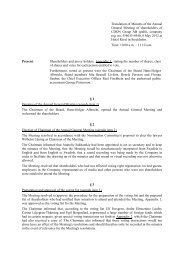Annual Report 2010 - CDON Group
Annual Report 2010 - CDON Group
Annual Report 2010 - CDON Group
You also want an ePaper? Increase the reach of your titles
YUMPU automatically turns print PDFs into web optimized ePapers that Google loves.
62 <strong>CDON</strong> <strong>Group</strong> AB<br />
<strong>Annual</strong> Årsredovisning report <strong>2010</strong> <strong>2010</strong><br />
2.21 Parent company accounting policies<br />
The parent company prepared its annual accounts as per the Swedish <strong>Annual</strong> Accounts Act (1995:1554) and Recommendation RFR 2<br />
Accounting for Legal Entities (December <strong>2010</strong>) of the Swedish Financial <strong>Report</strong>ing Board. The Swedish Financial <strong>Report</strong>ing Board’s<br />
statement on listed companies is also applied. RFR 2 means that, in the annual report for the legal entity, the parent company must<br />
apply all EU-approved IFRS and interpretations as far as possible within the framework of the <strong>Annual</strong> Accounts Act and the Act on<br />
Safeguarding of Pension Commitments, and with regard to the connection between accounting and taxation. The recommendation<br />
states which exceptions from and additions to IFRS must be applied.<br />
2.21.1 Differences between accounting policies of the <strong>Group</strong> and parent company<br />
The differences between <strong>Group</strong> and parent company accounting policies are stated below. The parent company’s accounting<br />
policies described below were applied consistently to all periods reported in the parent company’s financial statements.<br />
2.21.1.1 Changes to accounting policies<br />
Unless otherwise indicated below, changes to the parent company’s accounting policies in <strong>2010</strong> were the same as stated above for<br />
the <strong>Group</strong>.<br />
The changed accounting policies for the revised IFRS 3 Business Combinations and amended IAS 27 Consolidated Accounts and<br />
separate financial statements that are used in the <strong>Group</strong> are not applicable to the parent company as regards transaction fees and<br />
contingent considerations. More information is available below in the Subsidiaries section.<br />
2.21.1.2 Classification and presentation<br />
The parent company uses the names Balance Sheet and Cash Flow Statement for the reports that in the <strong>Group</strong> are called<br />
Consolidated Statement of Financial Position and Consolidated Statement of Cash Flows. The parent company’s income statement<br />
and balance sheet are prepared in accordance with the Swedish <strong>Annual</strong> Accounts Act’s schedule, while the statement of<br />
comprehensive income, statement of changes in equity, and cash flow statement are based on IAS 1 Presentation of Financial<br />
Statements and IAS 7 Statement of Cash Flows. The differences in parent company reporting versus <strong>Group</strong> reporting as seen in the<br />
parent company income statement and balance sheet mainly comprise reporting of financial income and expenses, equity, and the<br />
occurrence of provisions as a separate heading in the balance sheet.<br />
2.21.1.3 Subsidiaries<br />
Participations in subsidiaries are recognised in the parent company using the cost method. This means that transaction costs are<br />
included in the carrying amount for holdings in subsidiaries. In the consolidated accounts, transaction costs related to subsidiaries<br />
are recognised directly in earnings when they arise.<br />
Contingent considerations are valued based on the probability that the purchase price will be payable. Any changes to the<br />
provision/receivable increases/decreases the cost. In the consolidated accounts, contingent considerations are recognised at fair<br />
value with changes in value via earnings.<br />
2.21.1.4 <strong>Group</strong> contributions and shareholder contributions for legal entities<br />
The Company reports <strong>Group</strong> contributions and shareholder contributions per the Swedish Financial <strong>Report</strong>ing Board’s UFR 2<br />
statement. Shareholder contributions are recognised directly in the equity of the recipient and are capitalised in shares and<br />
participating interests of the issuer, to the extent impairment is not applicable. <strong>Group</strong> contributions are recognised according to<br />
financial implications. This means that <strong>Group</strong> contributions made and received with the objective of minimising total <strong>Group</strong> tax are<br />
recognised directly against retained profits after deduction for its actual tax effect.




